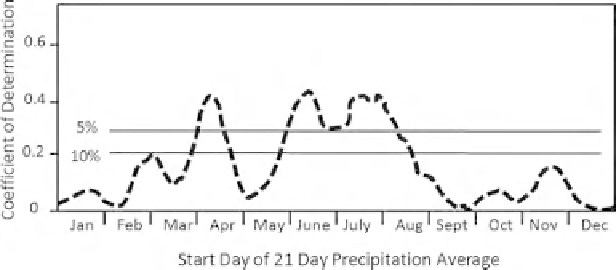Geoscience Reference
In-Depth Information
Figure 25.3
Between 1981 and 1994, the 21 day running average of the coefficient of
determination between the average soil moisture measured to a depth of 10 cm at sites in
the Illinois Climate Network on each day of the year and the statewide average
precipitation for Illinois measured over the subsequent 21 days. The horizontal lines show
5% and 10% levels of significance in the coefficient of determination. (Adapted from
Findell and Eltahir, 1997.)
It is also plausible that transient changes in the amount of water available for
release from the soil can influence climate and weather in different ways,
specifically by:
1.
contributing to changes in atmospheric water concentration (see previous
section);
2.
modifying the downwind structure of the atmosphere and in this way
modifying the probability of precipitation; and/or
3.
generating mesoscale circulations in the atmosphere in response to spatial
differences in the surface energy balance if the spatial pattern of soil moisture
is heterogeneous.
Hydrometeorological records provide some observational evidence that transient
soil moisture status influences precipitation during the summer months. Findell
and Eltahir (1997), for example, plotted the coefficient of determination between
the average soil moisture measured at sites in the Illinois Climate Network on a
particular day of the year and the state-wide average precipitation during the sub-
sequent 21 days, see Fig. 25.3. They suggested that during summer a significant
amount of the variation in precipitation could be explained by antecedent soil
moisture status. Early convincing evidence for the influence of soil moisture on
precipitation was also provided in a modeling study made with the European
Centre for Medium-term Weather Forecasting (ECMWF) model (Beljaars
et al.
,
1996) which showed that introducing improved modeling of the seasonal evolu-
tion of soil moisture resulted in enhanced skill in predicting the major Mississippi
floods in the summer of 1993. Better modeling of soil moisture gave improved
simulation of the vertical profile of atmospheric temperature downwind, with
warmer air aloft and greater opportunity for deep cloud and heavier convective





